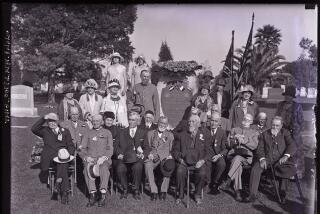Human side of Sherman’s march
THREE years ago, we were invited to see the story of William Tecumseh Sherman’s march to the sea through the eyes of novelist E.L. Doctorow in “The March,” a series of fictional (or fictionalized) vignettes. Now we are offered a kind of reality check in “Southern Storm,” a work of history that relies on hard facts and the actual words of those who were there and yet manages to present the story with clarity, coherence and even a kind of tragic grandeur.
Sherman proposed marching a Union army out of newly conquered Atlanta and across Georgia to Savannah in 1864, tearing up the railroad lines and destroying the enemy infrastructure along the way. The goal was to deliver a death-blow to the Confederacy by cutting its lines of communication, supply and maneuver. But Sherman understood that he could not carry out the plan unless he dispensed with the supply train that customarily followed a 19th century army with rations and supplies. Rather, he would allow his men to “forage liberally” along the way -- that is, to take what they needed from the civilian population -- and thereby earned his reputation as a kind of latter-day Attila the Hun.
“If Georgia can afford to break our railroads, she can afford to feed us,” he said. “Please preach this doctrine to men who go forth, and are likely to spend it.”
Noah Andre Trudeau, a former National Public Radio producer and author of the well-regarded “Gettysburg: A Testing of Courage,” has retrieved a wealth of source material -- letters, journals, speeches, newspaper accounts, even weather reports from both sides -- about one of the most famous (or notorious) operations of the Civil War, and he succeeds in constructing a seamless historical narrative out of the bits and pieces of human memory. The specialist reader will appreciate his care and diligence in the handling of source material, but the general reader will also find much to admire and enjoy in these pages. Day by day, sometimes hour by hour, we are able to march along with Sherman and his men from Atlanta to the Atlantic.
Opportunity of war
Although the book is a history rather than a biography, Sherman himself stands out in high relief. Haunted by the death of his young son, a failure at banking, law and real estate, he was ready to “hide myself in any obscure corner” when the outbreak of the Civil War opened a new opportunity.
His wife lobbied her own influential relatives to secure a field command for her husband, and his posting to the army commanded by Ulysses S. Grant at Shiloh, Tenn., turned out to be the first step toward greatness. “He stood by me when I was crazy,” Sherman later recalled, “and I stood by him when he was drunk.” Even at the height of his fame as a battlefield hero, however, he was still described by one soldier as looking like “some old farmer, his hat all slouched down and [wearing] an old brown overcoat.”
Sherman was dedicated to the cause of the Union, but he was half-hearted about the liberation of slaves and actively opposed enlisting them in his army. “I have had the question put to me often: ‘Is not a negro as good as a white man to stop a bullet?’ Yes, and a sand-bag is better; but can a negro improvise roads, bridges, sorties, flank movements, etc., like the white man? I say no.” On that point, he was not so different from the Southern matron who insisted, rather indignantly, that slave keeping was sanctioned by the Bible: “I can see nothing in the scriptures which forbids it.”
Above all, Sherman was ruthless in battle, a trait that turned out to be essential to the success of his march to the sea. When he negotiated with the Confederates for an exchange of prisoners, for example, he was willing to trade his own POWs only for Union soldiers who were healthy enough to be returned to the ranks.
The ill and injured soldiers who arrived at the exchange point “were turned around almost in sight of their liberation,” Trudeau writes. Later, the soldiers under his command were admonished not to waste their ammunition on slaughtering livestock: “Let the men catch and kill their hogs with their sabers,” one officer declared, “a weapon that can be used equally as well to kill hogs as rebels.”
Damage done
Yet Trudeau also points out that the operations were neither quite as barbaric nor as one-sided as they are advertised to be, especially in the long memory of the South. Union soldiers encountered armed resistance on their march to the sea, and most of the damage they managed to inflict was directed toward railroads and government buildings rather than civilian dwellings.
One soldier from Michigan, for example, was ready to put his torch to a house when he was confronted by a 10-year-old girl: “Mr. Soldier,” she said, “you would not burn our house would you, if you do where are we going to live?” As the soldier himself recalled, the little girl “looked into my face with such a pleading look that I could not have the heart to fire the place, so I dropped the torch and walked away.”
‘Holy war’
It’s impossible to read “Southern Storm” without occasionally thinking of the headlines in the daily newspaper. At the worst moments of the Civil War, for example, some Southerners argued for making peace with the Union, but Jefferson Davis insisted that success in battle was the only way to end the war. “Victory in the field is the surest element of strength to a peace party,” he declared, sounding a bit like our own president. And Sherman insisted that he was fighting “a holy war, with absolute right on our side, with pure patriotism,” and he saw the defeat of the South as an opportunity for “the United States of America to resume her glorious career in the interest of all mankind.”
The unspoken theme of “Southern Storm” is that all wars, then and now, are fought by flesh-and-blood human beings, and Trudeau’s real achievement is that he allows us to see their faces, to hear their voices, and to look into their hearts and minds. And he does so with both a historian’s discipline and a novelist’s eye for the telling detail.
--
Jonathan Kirsch is the author of, most recently, “The Grand Inquisitor’s Manual: A History of Terror in the Name of God,” due out in September.
More to Read
Sign up for our Book Club newsletter
Get the latest news, events and more from the Los Angeles Times Book Club, and help us get L.A. reading and talking.
You may occasionally receive promotional content from the Los Angeles Times.









